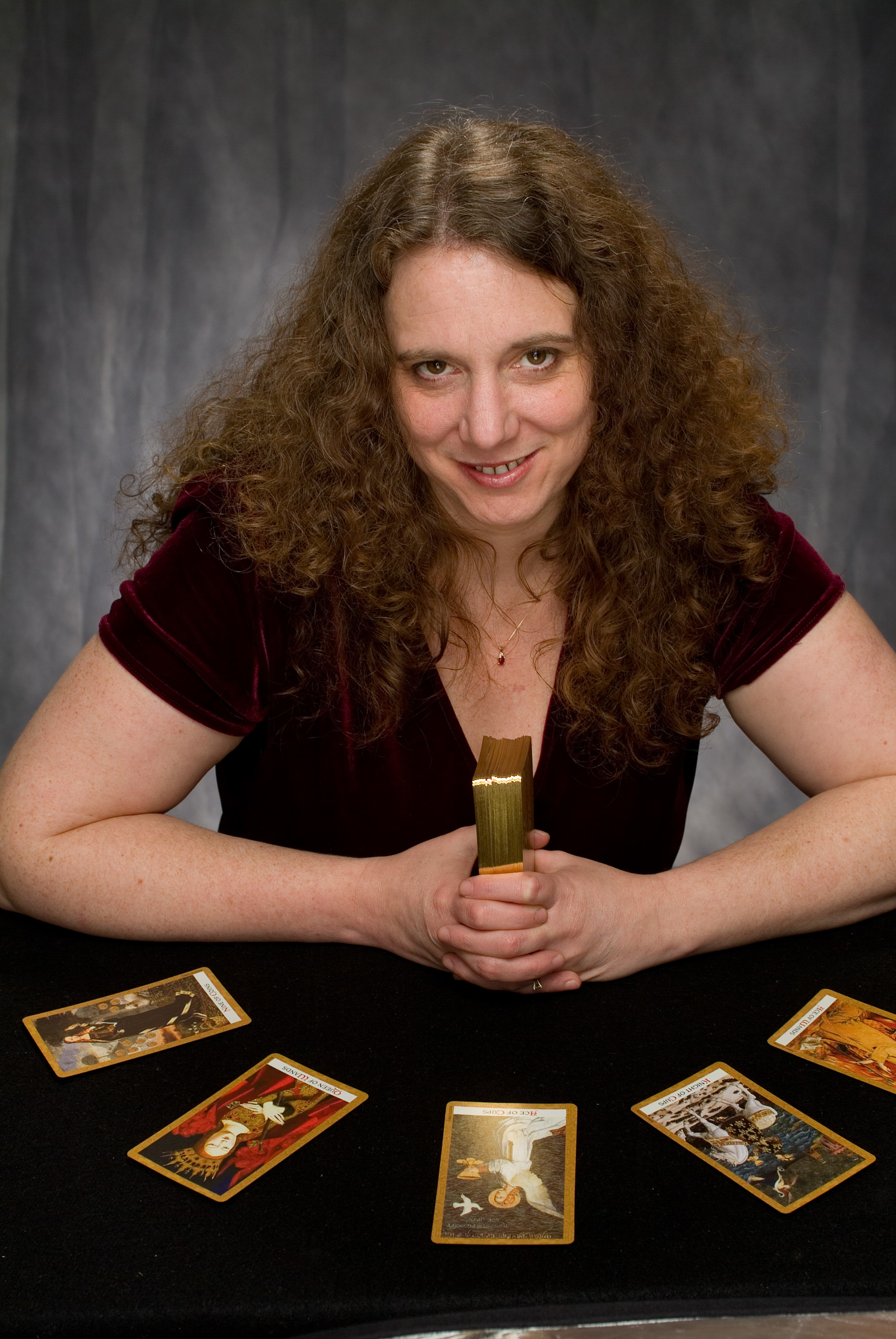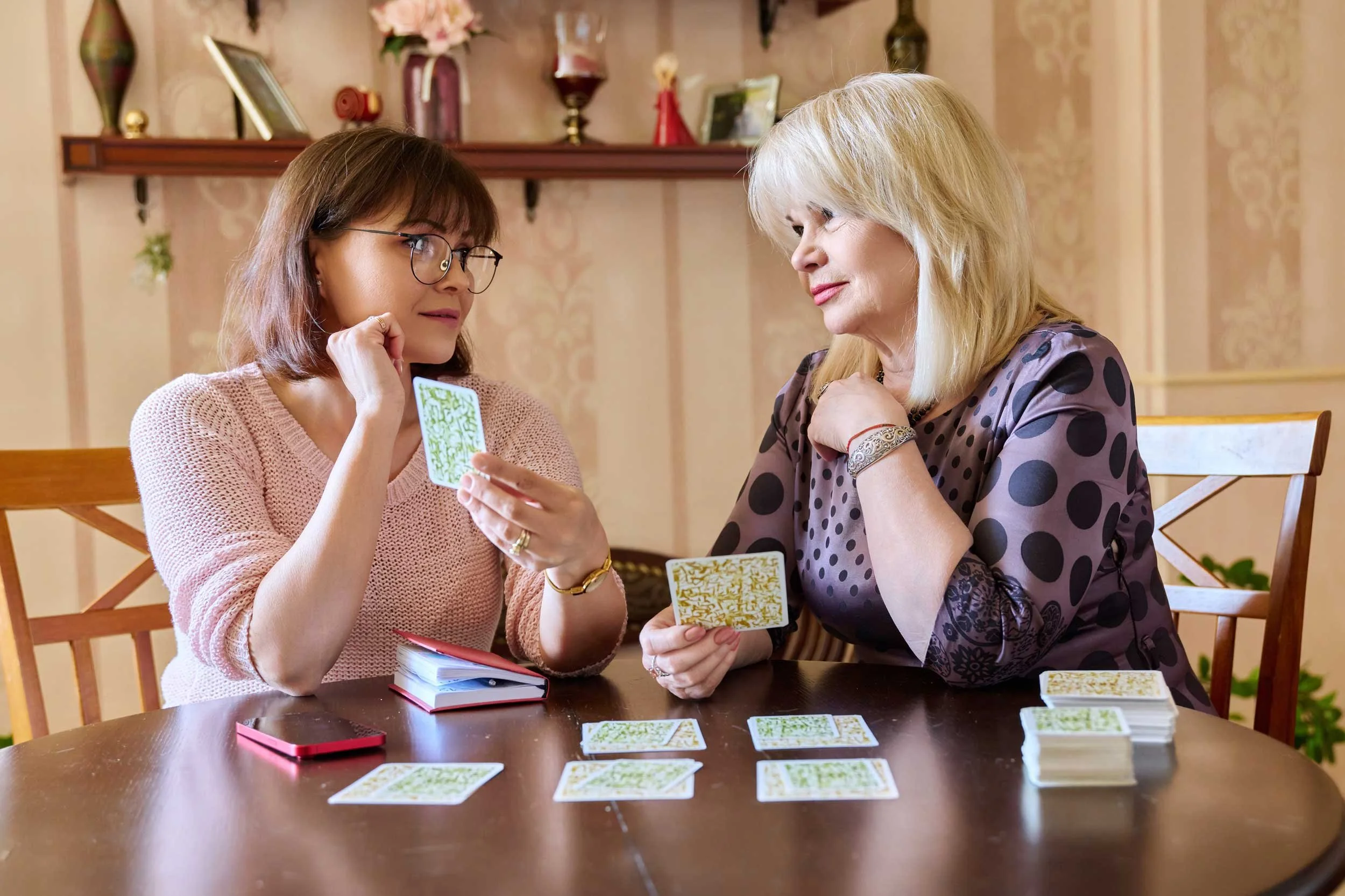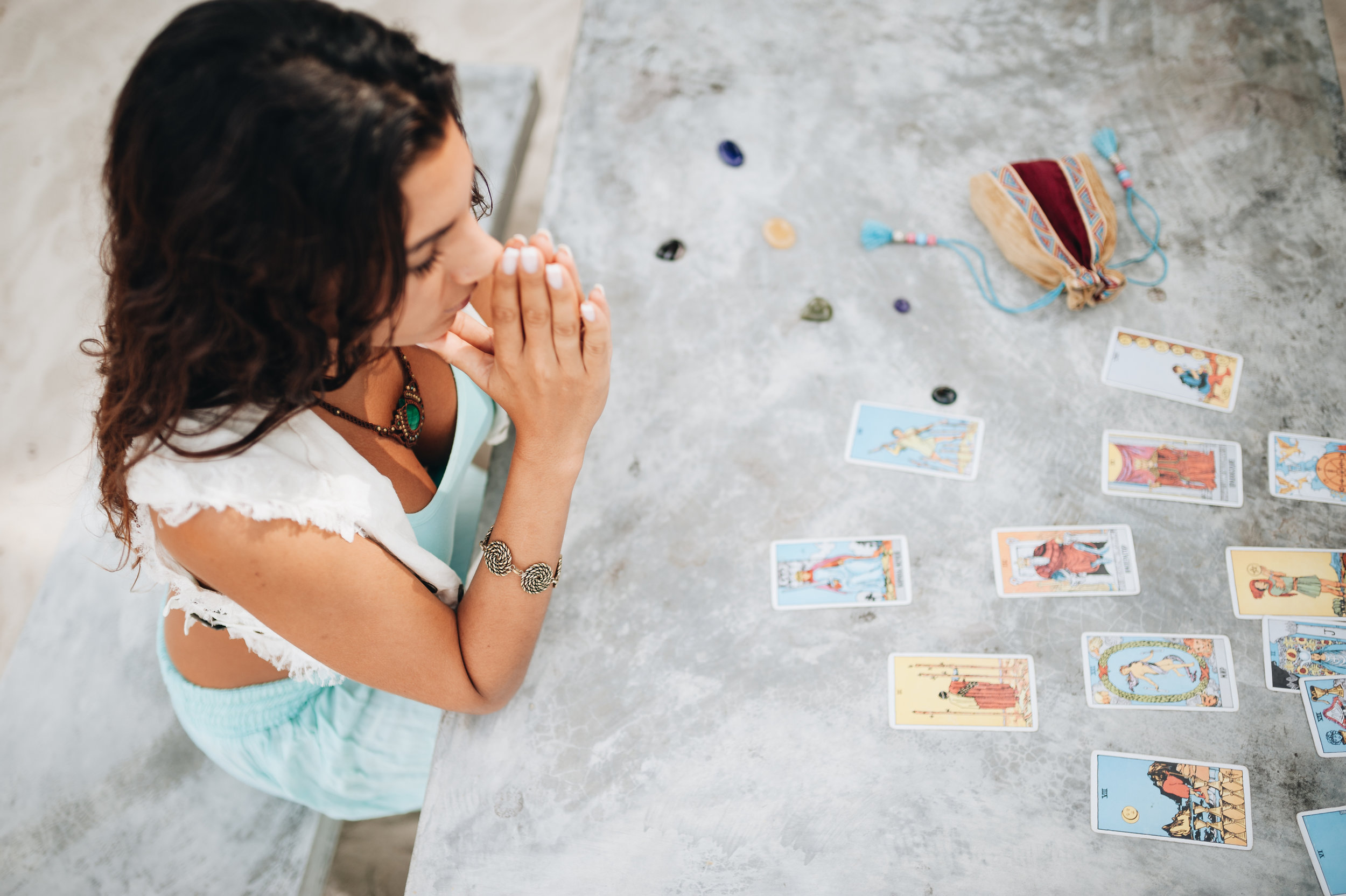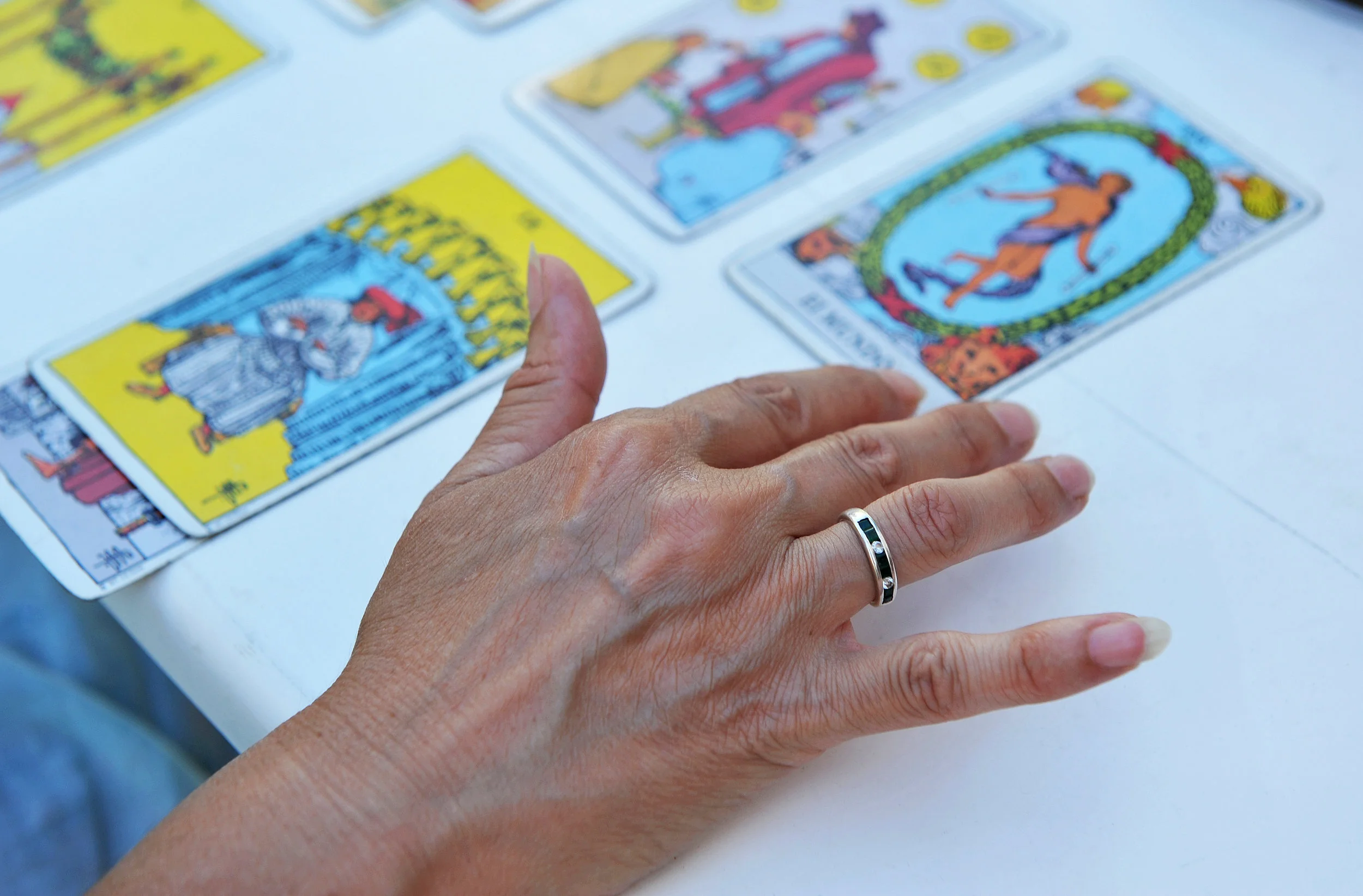
Welcome to my personal blog.
Here you will find my musings, thoughts and observations, all inspired by my experiences as a full-time professional tarot reader.
Backing Into a Delicate Reading
Here is a supportive, helpful way to handle difficult client questions.
I still offer free classes and meetups after almost thirty years of being a full-time tarot professional. Informal tarot gatherings offer me the invaluable opportunity to learn how to describe, quantify, and teach the techniques I have developed innately over years of full-time tarot reading.
When I gather with other tarot professionals at conferences like StaarCon I discover that many of my peers have developed some of the same techniques. They may have similar or different ways of naming them and explaining them.
Tarot reading techniques are incredibly personal. No two readers will have the same style, though many of us share similarities in our ethics and approaches.
One way that readers differ from each other in is their ethical comfort and technique in handling delicate questions. Something came up during our recent Cards and Conversation Tarot Meetup at Panera Bread in Palm City. The way we handled it as a group helped me understand a technique that I have used unconsciously for years. The meetup brought this technique into focus for me, so now I can succinctly share it.
What is a delicate question for a tarot reader? Very often, questions related to health, especially in dire or extreme circumstances, can be one area of concern for readers.
Some readers simply refuse to answer any questions related to health. Some readers refuse any third-party questions. That is, questions about people who are not present and did not consent to be part of the reading.
Other readers try to work with every requested topic but may choose to rephrase the question. For instance, “What will be the outcome of my mother’s upcoming surgery?” might be rephrased to “What do I need to know about my mother’s upcoming surgery?” or “How can I best support my mother during her surgery?”
There are also readers who believe that the question should be posed of the cards exactly as the querent asked it, without any rephrasing.
I try to answer most questions client ask me. I will often rephrase, but I will not always make an obvious point of rephrasing.
At the meetup, we were doing readings for each other. One person would ask a question, and then anyone in the group who wanted to ring in would pull one card and give their answer.
The question that came up was regarding a family member in a precarious health situation. I used this as a teachable moment. I asked for a show of hands. If you received this question in a one-on-one setting, how many of you would politely refuse to answer? How many of you would offer prayer or tarot magic instead of prediction? How many of you would do the reading on the question as it was asked? How many of you would rephrase the question?
I tried to conduct this discussion in a way that was supportive of the person asking the question, and supportive of everyone’s thoughts about how they each might approach this delicate question.
Not one person in the group of fourteen people wanted to answer the question as it was asked.
We worked together on rephrasing the question. Then, those who felt called pulled single cards in answer to the rephrased question.
As the process unfolded, I noticed something significant. The cards that appeared in answer to the rephrased question were helpful when interpreted within the context of the new question, just as one might expect.
Yet, each of those same cards also had specific references within them to the original question. Each of the cards pulled to answer the rephrased question, if interpreted in answer to the original question, offered very specific information relevant to the original question. Nicely, these interpretations offered hope, solace, and the possibility of a positive outcome.
What happened here?
We know that we need to interpret cards in the context of the question asked, or the spread position in which they fall. But we also know that the cards we pull can offer additional information. In a positioned spread, cards can pop out of their position to offer extraneous and addition information, advice, and predictions. When answering a specific question, the card can be interpreted to answer the question, and then re-interpreted to offer more insight.
In this case the insight clearly offered the best possible answer to the original delicate question.
In describing what I was seeing and feeling, I realized that this is a technique I have been unconsciously using for years.
Here’s what to do if you want to try this technique the next time someone asks you a delicate question.
Rephrase the question and read for the rephrased question. If the cards that appear seem to speak to the original question, decide if the information they are offering is helpful to the querent. You may relay this information directly, or simply use this new information to adjust your tone, and help them set their expectations.
In the moment at the meetup, I referred to this technique as “backing into the reading”. Rather than answering a potentially upsetting question directly, we set up a circumstance where we could offer helpful information without being predictive. When the cards themselves came up making a prediction, we were able to decide whether to share that prediction, or how to let what we saw in those cards influence what we said to the questioner.
Now that I understand that I have been doing this with delicate questions for years, I am happy to be able to quantify this helpful technique and share it.
Do you ever back into a delicate reading? Is this something you might consider trying?
Choosing the Best Tarot Technique for the Worst Questions
Here is an intuitive tarot technique for yes or no questions.
I love teaching tarot classes. During a recent Zoom class, a question came up at the end of the class. It was the sort of question on which I could base an entire class, or at least a blog post. So, here goes.
The scenario is one with which we are all familiar. A tarot client has a specific yes or no question which will be immediately proven right or wrong. Rather than waiting for the pregnancy test, the job offer, the Xray, or whatever will provide the definitive answer, they want to hear right now from tarot what the answer will be.
The reader performs a comprehensive tarot spread like a Celtic Cross. Within the spread, and perhaps, most convincingly, in and near the ‘future’ or ‘outcome’ position, there are cards which we typically traditionally associate with the nature of the question. We see the Empress for a question about pregnancy. We see the Three of Pentacles for a question about a job. Based on the appearance of those cards in those positions, we give our answer. When the client gets the news from the official source, it turns out that what we thought we saw in the cards, and what we told the client, was wrong.
When this question was posed at the end of class, my thought was that Spirit does not always see things in the same linear way we do. For Spirit, the difference between being pregnant now, or in a month, or being hired now, or in two months, may be very negligible.
Perhaps Spirit is like a loving but stern parent who will direct us to the best source of answers for the question we have. Perhaps Spirit wants us to be patient.
In class we discussed ways to handle this kind of question, and ways to provide the answer in a broader scope. That was all we had time to do in class. There is so much more to unpack here.
The first consideration is about those kinds of questions. Why would a person want tarot to answer something when a mundane tool, or a little patience, would provide the best and most accurate answer?
Sometimes there is a good reason. Life can have a lot of moving parts. We need to sign the lease now if we are going to get the great apartment, but only need the apartment if we get the job. In a situation like that, tarot is the best tool to create a great strategy for managing those moving parts.
In the situation where there is no logical reason to use a mystical tool when a mundane tool is the better option, there is usually something more at play. The seeker wants to infuse a touch of the divine, of the spiritual and the mystical, into their situation. They may not have the vocabulary to ask a deep question about their circumstance, so they ask the most direct question on their mind. It is up to us, as readers, to break that question down and provide them with the mystical experience they seek, whether we can ferret out the exact answer they think they want, or not.
As we discussed in class, we find our flow in a tarot reading by implementing our energetic and spiritual resources, our knowledge of the cards, and proper technique.
As I thought about this question, I came to this clear realization.
When we are in a situation where we need to examine a definitive yes or no, a broad comprehensive spread like the Celtic Cross is not the best technique.
Over the years, I have developed a technique that I call “weighing the cards”. This technique is invaluable for answering specific yes/no questions.
My own experience has been that using yes/no spreads or activating certain cards to indicate a yes or no answer hasn’t been effective for me. The weighing the cards technique has worked wonders. Each reader is different. We all must find the technique that works for us. The important part is to know many techniques, so we can apply the best technique for the situation at hand.
Here is how weighing the cards works. Suppose the question is, “Will I get this job?”
I will pull one card for “You get this job”. I pull a second card for “You do not get this job”. I weigh the two cards against each other in the context of the question. Sometimes they both point to the affirmative or the negative. Sometimes there is a clear feel toward the no card, or the yes card.
If they both seem neutral, or I cannot get a good feel, I will repeat the process, pulling cards, one in each pile, until a clear story emerges.
It is important to remember that, even in a situation where we might believe there is a clear yes or no answer, there might be other factors. You might be pregnant, but quickly miscarry. You might not be pregnant now but become pregnant quickly. You might get a job offer that is not what you expected and choose not to take it. You might get the job offer, but then get another offer which you take instead.
Sometimes I will use the weighing method and add a third card, or third pile of cards, which is, “something else happens”. This can help me see those complicated unexpected things.
Sometimes it is important to break a single question into many. “Am I pregnant?” might break into, “Will there be a baby soon?” “How will pregnancy go?” “What will be the challenges of motherhood?” “How will the father adjust?” “What will the baby be like?”
“Am I pregnant?” is best answered by a pregnancy test. The deeper questions that surround the concept of a new child can only be answered by divination. When we can pivot the question to the place where our tool shines, we can get better results.
When we need to attempt those yes or no questions, the using the right technique will give us the best chance for success. You may find, as I do, that the “weighing the cards” method is the right technique for you.
In divination with tarot or any tool, the more techniques we know, the more skillfully and accurately we can find our answers.
How Did This Show Up in the Cards?
How did our current crisis make itself known in the cards? What do the cards say about it now?
How Did This Show Up in the Cards?
Part of the process of reading predictive tarot for yourself is retrospective. Sometimes it feels like the cards try hard to tell us something that we can’t quite see. Then, an event occurs that causes us to say, “Oh! That is what this card has been trying to tell me.”
A great example of that was my mother’s cancer diagnosis and death. In the months before the phone call that changed my life, I had been stalked by the Six of Cups. It was not until my husband and son and I moved to my family homestead to care for my mother, and ultimately inherited that historic house, that I understood the poignant message of the Six of Cups.
One might wonder, then, the value of predictive self-reading if we can’t always see what the prediction is until it has already come to pass. Actually, there is great value there. The Six of Cups served as a beacon for me during that difficult transition. The Six of Cups told me that it was correct to upend my business, my life, and my family to make this out-of-state move to try to help my mother and manage her affairs after her passing. The Six of Cups told me that my mother’s passing was inevitable; one of those things that is ‘written’, rather than something I could have changed. I found immeasurable comfort in that.
We professional readers can often see societal trends in the cards of our clients. I wrote about this last year in a blogpost entitled What Tarot Readers See About the World.
The question is, how did a worldwide pandemic show up in the cards? I am encouraged that, in the past few months, I haven’t seen a slew of doom and gloom, financially or health-wise. Yet, when I think about it, I did see a lot of cancelled trips (Chariot reversed). I did see job changes (Ace of Pentacles reversed, Three of Pentacles reversed). I did tell a lot of people to be careful about their health. I told folks that they would be teaching classes online. I told folks that they would be spending more time with their kids.
In retrospect, the two cards that have been presenting a lot more often than usual are the Hermit and the World. Now, that makes a lot of sense.
Another card I see quite often these days is the Seven of Swords. This card appears to describe those who are cavalier in their approach to social distancing. In some cases the Seven of Swords appears to describe the virus itself as the unseen enemy lurking.
At the beginning of 2020 I did a reading for the year and shared it in a blogpost. The questions I asked were about the thing that was bothering me most at the time; the great polarization and division between Americans.
Now that we are in an unprecedented world event, I thought it would be interesting to go back and look at the cards that appeared, and to see if there was any foreshadowing of this great crisis, or any wisdom we might derive from those cards.
I had asked three questions and pulled three cards in answer to each. The final question was about where we would be at the end of 2020. Would we still be a divided nation? The cards that came up were the Hierophant reversed, the Fool, the Wheel of Fortune Reversed.
Knowing what we now know, these cards take on a new meaning for me. The Hierophant reversed could be about eschewing science and good medical advice, as well as the high price our medical workers are paying in the pandemic. It could also show an end to business-as-usual at the highest levels of government. The Wheel of Fortune reversed could speak of this difficult cycle we have found ourselves in, and the many people who are suffering. The Fool could speak of our naïve ways of handling this crisis. Yet, the Fool also offers the hope of a new beginning, and a new journey at the end of the crisis.
Every tarot reader works in their own way, as does every intuitive. I think for a lot of us it is hard to interpret things that are unthinkable. Now, global pandemics are suddenly a reality that will always stay fixed in our mindset. In the future, when this nightmare is over, if I see the World and the Hermit together repeatedly, I will wonder if another pandemic, or other global event, is on its way.
The hopeful news is that as I continue to read for people, positive things appear in everyone’s cards. I see business, I see relationships, I see weddings, I even see travel. Within the cards of each person it is clear that the world is not ending, it is simply on pause.
Another way that predictive self-reading is helpful is this. Once we are in a situation, we can find wisdom on how it might evolve, and what might happen next.
Of course, the one thing we all want to know is how long this crisis will last. Timing is often one of the hardest things to figure. In this case, when this ends will depend so much on what people do right now. Yet, I still feel compelled to ask the cards some questions.
What do I personally need to know about this pandemic?
Hermit reversed, Ten of Wands reversed, Page of Wands
Well, that’s pretty clear. My job is to continue to do what I am doing. I must continue giving readings and encouraging our community with live broadcasts and online classes.
When will this crisis be over?
Ten of Cups, Six of Cups, Queen of Cups
That is certainly hopeful, and to me suggests a return to some kind of normalcy somewhere between June and October.
These three cards offer the sort of comfort and hope that reminds me how helpful tarot can be.
Sometimes the cards give us a full picture of what to expect. Sometimes the cards give us only clues. I have to trust that in every case what we see is what we need to see.
When we look back, old readings are often able to offer new insight. This is why keeping a record of the cards we pull can be so enlightening. Whether we are looking to the future or the past, tarot helps us understand the now.
These days, we are more in need of understanding than perhaps every before. I have been a tarotist for thirty years. Yet, tarot never ceases to amaze me with its ability to comfort, to inform, and to offer wisdom and insight when we need it most.
Spreads, Pulls and Dialogues
A good tarot practice involves multiple techniques. Some readings require positioned spreads, other require a different treatment. Here are six proven ways to get the information you need from your tarot cards.
Spreads, Pulls and Dialogues
Six Proven Tarot Techniques
The explosion of tarot popularity means there are ever-more folks learning and sharing tarot. This is an awesome thing! Yet, it also means, with more voices in the mix, that there is more room for confusion and misinformation.
Tarot is an interesting thing in that there is no one right way to do things. There are multiple traditions. Since tarot is a tool of creativity, we are discovering new techniques all the time.
The downside is that many new tarotists end up confused, finding that the techniques they have learned fall short in delivering pertinent information.
Here, then, is a short primer on some of the most effective ways to work with your cards in divination.
Comprehensive Spreads
A comprehensive spread is a spread that has positional meanings for many departments of life. The Celtic Cross, the Seven Sisters and the Astrology Wheel are all comprehensive spreads. When using these spreads, it is often best not to have a specific question in mind. Just be open to what the universe has to say and interpret the cards in the context of the positions in which they fall. You may find that a comprehensive spread generates questions that you will want to use other techniques to answer.
If you are interested in learning to master a modern Celtic Cross, and comprehensive spreads in general, you can take my video class.
Topical Spreads
A topical spread is a positioned spread designed for a specific purpose, to answer a specific type of question. The Body/Mind/Spirit three-card spread is great to check in on overall well-being. A relationship spread is great to check in on a relationship. A career spread is helpful in understanding your career direction.
You can find many of these types of spreads online and in books. Use them when you have a specific type of question.
Custom Spreads
A custom spread is a positioned spread that you create for a specific issue. Imagine you had a dream you wanted to interpret. You could create one position for each element of the dream and add a position for each question you have about the dream.
If you were having trouble with a specific relationship you could create one position for each question you have about the relationship.
If you are making a decision you may have one card as the result of choosing each option, or two cards for each option, letting one card give the pro of that choice, and the other, the con. You may use a custom spread only once, or you may create a spread that you save to use again the next time a similar situation arises.
Non-Positioned Spreads
A non-positioned spread is a specific number of cards pulled in answer to a question, where none of the positions have meaning. You might read the cards as a sentence, or as a sequence of events. Or, you might blend the meanings of the cards together to get your answer. You might rearrange the order of the cards in a way that makes more sense to you.
There are two kinds of non-positioned spreads. One kind of non-positioned spread is to simply pull three cards and read them in whatever way makes sense. It’s usually not advisable to try to use more than three or four cards with this technique. Non-positioned spreads of five or six or more are usually quite confusing, unless you try the following technique.
The second type of non-positioned spread involves more cards, maybe six or as many as nine. Here, however, the reader generally has a protocol for reading the spread. Even though there are not specific positions, they may read cards on the bottom as the past, for example, or cards on the end of the row as outer influences and cards in the middle as inner influences.
Use of these non-positioned spreads is usually a matter of reader preference. They allow for greater leeway in interpretation than a positioned spread, yet lack the structure a positioned spread can offer.
Single Card Pulls
A single card pull is exactly what it sounds like. Ask a question and pull a card in answer. If the card you received doesn’t easily answer your question, you have two choices. One is to meditate on the card, research the card and spend time in contemplation to derive its message. The other is to expand your single card pull into a tarot dialogue.
Tarot Dialogues
A dialogue is a conversation with the cards. Ask a question and pull one card in answer. If the answer isn’t clear, pull one or two more – as many cards as intuition tell you to pull. Within that string of cards find a story, or extenuating information pertinent to your question. Does another question arise from this answer? Shuffle all the cards you pulled back into the deck and ask that question. Again, pull a card, or a string of cards, to get that answer. Does that generate a further question? Continue the process until you have a clear view of what is going on. If one or two cards keep repeating, take that as an overall message of supreme importance.
Whatever technique you use to read your cards, you will find that some cards seem very clear, and others confuse you. Do not dismiss the confusing cards. Recognize those cards as an opportunity for deeper contemplation and introspection. You may pull a card to clarify a confusing card. I think it is best to save clarifiers only as a last resort, and to not use them habitually.
In positioned spreads, you might find that some cards make sense to the situation, but not in the position they appear. It’s okay to use the positions as a guide, without being too rigid. Find the value in the cards that appear and know that sometimes the positions will be absolutely poignant in their accuracy, and other times the cards will scream truth while the positions will fade into the background.
To get the most out of tarot, it’s important to learn as many techniques as you can, because different circumstances call for different approaches. As you practice, read for as many people as you can. Read for yourself and keep a record of your self-readings. With tarot, the more you read, the more you will learn the specific and unique ways in which the cards speak to you. Do not wait until you are off-book to begin practicing. It is in the practice of reading that you will learn to memorize the cards and understand their wisdom.
Double Vision: Notice This Trend in Your Tarot Readings
Here's a new way to get information from cards in a tarot spread!
Double Vision: Notice This Trend in Your Tarot Readings
Here's a new way to get information from cards in a tarot spread!
Understanding how the cards work together, what I like to call “trends and blends”, is essential to effective tarot reading.
Most readers pay attention to the card numbers and will make note of a trend of more than one of the same number or rank appearing in a spread, or of a consecutive run within suit.
Recently I have started noticing cards within suit with doubled numbers. That is, when the four and eight of the same suit appear together, or the three and six. Very often, doubled-number cards work together, even if they do not appear next to each other in a spread.
Double number cards may tell a story. One card may provide a resolution for the problem shown in the other card.
For example, the Four of Swords suggests meditation as a remedy for the anxiety of the Eight of Swords.
The Six of Cups reminds the Three of Cups not to party too much, lest we do something we will regret in retrospect.
The Six of Swords suggests that logical thinking will remedy the heartache of the Three of Swords.
I shared this concept with a tarot group recently. The connections, correlations and insights that came from that exercise were profound.
The next time you see doubled numbers within the same suit in a tarot spread, see what additional messages you can pull from that configuration.









